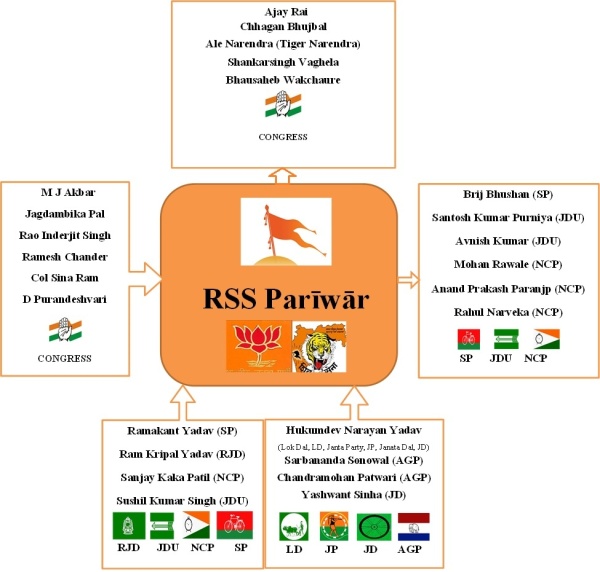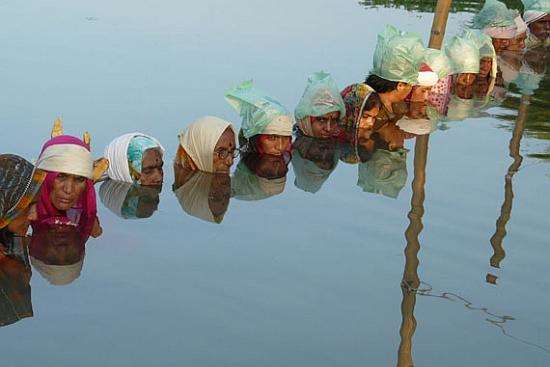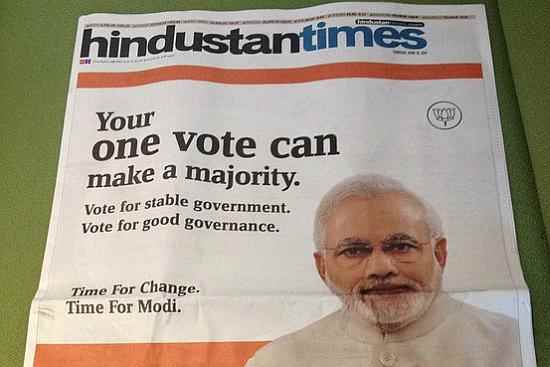MAY 25, 2014
Guest Post by IRFAN AHMAD
This article offers a preliminary analysis of what the Modi phenomenon means in terms of BJP’s sweeping win on 16 May. It makes four propositions.
First, we stop seeing it as an individual phenomenon centered on the personality of Modi even as his votaries as well as some critics tend to view it that way.
Second, the Modi phenomenon is triumph of a massive ideological movement at the center of which stands the Rashtriya Swayamsewak Sangh, RSS. Sharply distinguishing between the BJP and the RSS is a naivety; the RSS’ influence goes far beyond as numerous politicians under its influence have gone to the non-RSS parties in the same way as politicians from the non-RSS parties have joined the RSS-BJP collective.
Third, the BJP victory is neither due to development nor due to anti-corruption but due to Hindutva dressed as development so that both were rendered synonymous. The BJP victory, I contend, is an outcome of a violent mobilization against “the other”, Muslims.
Fourth, BJP’s victory is not the triumph of democracy but its subversion. Charting a different genealogy of demokratiain Greek, I argue how it is pseudo democracy.
As I explain these propositions, I request readers to be somewhat patient –they are a bit long, like the night of 16 May.
Charisma: Assembled, Loaded and Televised
In a live interview to a Singapore-based television channel on the final day of voting, I was asked what I thought of Modi as a “very charismatic person” and his track record of economic growth and delivery. Clearly, Modi’s charisma was no longer merely national; it was internationalized much like the profiteering McDonald as a brand. Such a ubiquity of wave or charisma of Modi entails understanding charisma afresh. For sociologist Max Weber, charisma means the belief among followers in a leader that he has an extraordinary quality as a gift from the grace of God. But how do followers think of someone as a leader in the first place? And how do they subsequently believe that the leader has charisma?
There is no inherent charisma; certainly, not in the 2014 elections. It was built brick by brick by turning corporate theft, ecological degradation and the state-supervised pogrom into development, silenced dissent into celebrated consensus, large crimes into even larger rallies of pride (recall gauraw yātrās). The charismatic leader saw corruption and showed corruption to people only in his rival parties but never told people about Bangaru Laxmans or B.S. Yedurappas and several others within the party whose corruption doesn’t even become a public issue. That is, charisma emanated from showing corruption outside while hiding it within. Yes, it required charisma to dub those speaking out against the state violence of 2002 as promoting divisiveness over development. These “conservatives” clung to the past while the charismatic leader wished to “move ahead” on the highway of future “development” he had already delivered.
In short, the transformation of political ugliness into a bumper sale of development with charismatic Modi at the center required much labor, creativity, coordination, manpower, involvement of internationally-trained professionals, production of comic books to inspire children through Modi’s personal life story and a gigantic sum of money. In one estimate Rs. 5,000 crore (over US $900 million Dollars) was spent on advertisement alone (EPW, 24 May, p.7) –at the rate of Rs. 20 per lunch, the entire population of India, 125 crore, would have enjoyed lunch for full two days. But still all these wouldn’t have mattered significantly if they were not televised by media which obediently did. It won’t be unreasonable to say, then, that Modi’s charisma is a gift from the grace of mammon, television, Google, social media and YouTube.
The Omnipresent Collective behind the Individual
If charisma is not an inherent quality dwelling within the individual – charisma of Vinoba Bhave the “saint” who engineered the Bhoodan movement and is considered one of the most charismatic leaders in independent India was enmeshed in an economic matrix and crafted by the massive political machinery and leaders of that time, Jawaharlal Nehru included (TK Oommen “Charisma, Social Structure and Change”, Comparative Studies in Society and History, 1967) –what is the political collective that explains Modi’s charisma? The answer is short: the RSS which has the explicit goal of making India into a Hindu state with Muslims as its prime foe. What was distinct about the 2014 elections was that RSS’ myriad organizations –in all age groups, across gender, every walk of life and every corner of India –swung into action on camera. Unlike in the past, the RSS and the BJP publicly and proudly acknowledged their mutual contributions. The mask that the RSS was just a cultural, not political, organization was cast off. So, the question if the BJP government would be remote-controlled by the RSS headquarters in Nagpur is redundant. A day after the victory, Uma Bharti, a senior BJP leader, told NDTV:
There shouldn’t be any hesitation (sankōch) in accepting that the RSS is our policy director (nītī nirdēshak). What they [the RSS] have taught us has got mixed in our blood. Therefore, they don’t even need to remind us [the BJP].There is no need for remote control [of the BJP by the RSS]. We have come under self-control through them. We too have begun to think the way they think. Therefore, there is no need for a remote control. Now the countrymen have put a stamp of approval on it [the RSS]. A swayamsewak of the RSS who has also been itsparchārak is set to become Prime Minister of the country… People themselves have accepted our ideology.
There is no further need to belabor this point for the Kafila readers. What needs to be stressed is that the influence of Hindutva is not limited to the RSS family for it goes far beyond and deeper. That the ideology of Hindutva –different from Hinduism as a religious tradition(s) prior to the Nineteenth century –is also shared by individuals in explicitly non-Hindutva parties and organizations has a longer history. KM Munshi (1887–1971) joined the Indian National Congress in 1929 and described himself as a Gandhian. While in the Congress, he had developed such close relations with the Hindu Mahasabha (HM) that many, including Bhai Premchand, ex-President of the HM, held that Munshi’s “ideas were just the same as that of the Hindu Mahasabha”. Munshi had also joined the akhāṛās, gymnasia, for “training our [Hindu] race in the art of self-defense”. Given his militancy, he was advised to leave the Congress. Later he established Akhand Hindustan Conference to become its President. That Munshi was a Hindu nationalist determined to reestablish the Hindu glory, calling Muslims “goondas”, foreigners, invaders and Islam constituting a dark chapter in India’s history, was manifest in his numerous writings. Well-known was also his friendship with the Hindutva ideologues: VD Savarkar, BS Moonje, and Shyama Prasad Mookerjee. Yet, in 1946, M.K. Gandhi asked Munshi to rejoin the Congress (Manu Bhagavan, “The Hindutva Underground”, Economic & Political Weekly, 2008).
Before I come to the post-colonial period, let me mention three other examples. Lala Lajpat Rai (1865–1928) resigned from the Congress to become the President of the Hindu Mahasabha in 1925. On Jawaharlal Nehru’s invitation Shyama Prasad Mookerjee (1901–1953), ex-President of the Hindu Mahasabha and founder of the Jana Sangh, predecessor of the BJP, joined the Cabinet Nehru formed after Partition. Pundit Madanmohan Malaviya (1861–1946), twice presidents of the Congress in 1909 and 1918, became the President of the Hindu Mahasabha in 1923 (Christophe Jaffrelot, Hindu Nationalism Reader, 2006, pp.61–62). With Malaviya’s help, the RSS started its shākẖasat the Banaras Hindu University (Pralay Kanungo, RSS’S Tryst With Politics, 2002, p. 49).
The crisscross between the RSS ideology/family and the non-RSS formations continued after 1947 as the table, by no means complete and based on individuals only (of more recent past) , shows below.
 Flows between the RSS Parīwār and “Secular” Parties, Post-1947
Flows between the RSS Parīwār and “Secular” Parties, Post-1947
The flow between the RSS ideological camp and the non-RSS parties is epic, not episodic, enduring, not fleeting. It grows out of a sustained ideological groundwork to secure political equivalence. As the table above shows, Ajay Rai switched from the BJP to Samajwadi Party and then to the Congress to contest against Modi in Varanasi. Rarely did Rai ever critique the BJP or Modi. His sole claim against Modi and Arvind Kejriwal was that while his rivals were outsiders to Varanasi he alone was a local (asthānīye) candidate. In a special session of the Gujarat Assembly bidding farewell to Modi, on 21 May, Shankar Sinh Vaghela, Congress Leader of the Opposition not only praised Modi but asked him to build the Ram Temple at Ayodhya (obviously the Babri masjid is not even an issue). He also backed Modi and the BJP on other contentious issues. Friedrich Engels’ (d. 1895) remark that “the names of political parties are never entirely right” has some merit.
My point about the political equivalence is not an external attribution but the self-claim by the RSS which should be duly acknowledged as it is. When asked about the RSS appeal across political parties, Ram Madhav, the RSS spokesperson said in 2009:
We have our members in several political parties, including the Congress. We interact with them regularly…The BJP is closest to us in…ideology. Someone is 10 feet away from us; someone else is 1 km away, that’s the difference.
Responding to a similar question, Mohan Bhagwat, the new RSS Sarsanghchālak, head, offered more details:
Joining parties other than BJP depends on the individual thinking of a swayamsewak. And swayamsewaks are present in many parties. This I can tell you. Have you heard of Tiger Narendra in Andhra [Pradesh]? … Earlier he was in the BJP, now he is not [later Narendra became an MP from the Congress in 1999 and from Telangana Rashtra Samithi in 2004]… I had gone to Varanasi where the President of the city’s weyāpāri mandal was from the Samajwadi Party as well as the gẖatnāyak [group leader] of our shākẖa there. In the camp (mahāshīwir) of Agra many district-level workers of the BSP took part… We don’t count who is from which party or caste…We consider them all Hindus.
Hindutva as Development
It is against this wider backdrop of the organizational infrastructure and ideological apparatus that the claim by the BJP and the media that the latter won on the plank of development should be unpacked. To begin with, there is no single party which is opposed to development; every party vouches for development. So how did development and the BJP become synonymous? Consider Bihar under Nitish Kumar in alliance with the BJP. As long as this alliance was in place, Bihar was projected as a model of development next only to Gujarat. However, as the alliance broke in June 2013, we were told, Bihar’s development not only stopped but also declined. In March 2014, The Times of Indiareported that its GDP dramatically declined from 15.05% during 2012–13 to an estimated 8.82% during 2013–2014. While I am not an economist, this conclusion would be convincing if it also showed a major shift in the policy in less than a year and causally linked it to the decline. So, the message of The Times of India was plain: the BJP alone could guarantee development because after the breakup of alliance, development of Bihar drastically declined. The report was not about political economy. It was more about politics and less about economy.
When the alliance between Nitish Kumar and the BJP was intact, Bihar was also regarded as a well-administered state in terms of law and order, “good governance”, again only next to Gujarat. Soon after the dissolution of the alliance Bihar returned to jungle raj. Giriraj Singh, a key Bihar BJP leader, said: “Since the breakup of alliance [between Nitish Kumar and the BJP] there is nothing called government…law and order [in Bihar]”.
The logic of development as a winning catalyst is flawed because in the states of Bihar and UP –from where the BJP won over 100 seats –the RSS-BJP had systematically manufactured an anti-Muslim polarization to consolidate the “Hindu Vote”. In UP it began with the Muzaffarnagar riots operationalized through an incident in Kaval village in August 2013 as a result of which over 50,000 Muslims were rendered as refugees living in various camps. In early January 2014, with some journalists-academics I visited many camps, including the village Kakra and the police station nearby. There was a perfect harmony in the accounts of villagers, police officials and Kakra chief (pradẖān). They all held that Muslims themselves burnt their houses and willingly left villages to claim compensation from the state government. They were “greedy”. So massive was this propaganda that the simple fact that the promised amount of compensation was far lower than the price of their lost land and properties didn’t matter. The police told us that they made every effort to arrest the culprits responsible for loot and arson but they could not find them. While in Kakra, we found the culpritsliving there without any fear; one of them saying that the police lacked courage to touch them. The Muzaffarnagar riots were preface to the 2014 elections which the BJP won.
Two months later, in October 2013, in Bihar too the anti-Muslim campaign began with the explosions in the Patna rally to be addressed by Modi. Soon after the blast, TV channels such as News 24 showed one Pankaj as culprit and police arresting him. Firstpost reported that Ramnarayan Singh, Vikas Singh and Munna Singh were suspects. Within hours, as Beyondheadlines noted, the narrative changed as did the names of the suspect. Suspects became Muslims and their names began to circulate on television screens. The National Investigation Agency arrested Aftab Alam from Muzaffarpur where my parents live. Though released after a few days, media was awash with equation between Islam and terrorism and both against India. The colony where Alam lived was described as “mini Pakistan” by local Hindi media as well as many people in the “civil society”. So terrorized were Muslims in Muzaffarpur that they stopped greeting Alam after his release. When I expressed my desire to meet Alam, many of my relatives advised me not to. I did meet him.
From the time of the Patna blast the political field was methodically mobilized along the religious lines as a result of which electorally Bihar was as productive to the BJP as was the UP after the Muzaffarnagar riots. It was precisely because of such a line of political enmity sharply drawn well before the elections with a specific electoral purpose that at their conclusion Modi said: “There is no enmity in democracy but there is competition”. Does not this appear like an affirmation through the crooked lane of denial?
Let me conclude this section on development with the statement of Uma Bharti. When asked if Modi would give priority to Hindutva over development, she said:
“Hindutva is breath of life (prān) of India… However, prān remains still in its place… Things which require maintenance are hands, feet and eyes –in other words, development”.
Faces of Pseudo Democracy: Terror of Mercy
A day before counting began Chetan Bhagat wrote a blog for The Times of India. Predicting that the BJP with “near boycott by the Muslim community” will win an “all-time high Hindu power”, he posed questions and answered them as follows:
What do the BJP and Indian majority do with this new Hindu power? Do we use it to settle scores with Muslims? Do we use it to establish a majoritarian, intolerant state where minorities are ‘put in their place’? Do we impose ourselves and say things like, ‘India is the land of Hindus’? Do we make laws more in line with Hindu religion?Frankly, we may have the power to do some of these things now. It may even appeal to sections of the population. However, be warned. This would be an awful and terrible use of this power. In the long term, such a thought process will only turn us into a conservative, regressive, unsafe and poor country where nobody would want to come for business (emphasis added).
While Bhagat’s questions are clear, his answers are not. Of the items listed in questions, in his answer he refers to “some of these things” leaving it for the readers “which ones”. What is clear, however, is that in warning about the terrible use of power, he brazenly violates the innate worth and dignity of humans and shows concern for them because “nobody would want to come for business”. Such a beastly urge –even beasts don’t have that –where treatment of humans (Muslims) is predicated on the calculations of profit and capital, is not a value for most followers of any religion, including Hinduism, in whose name Bhagat speaks. Bhagat’s vocabulary draws less from religion and more from its entanglement with supremacist nationalism and majoritarian democracy both of which must have been strangers to our forefathers in Vedic times. His invocation of the “Indian majority” which he equates with Hindus is a common, though flawed, understanding of democracy. Many dissenting with Bhagat’s lines of thinking, however, accept the idea of a Hindu majority but reject the BJP’s claim to represent all Hindus by arguing that two-thirds of them did not vote for it. Statistically, it is correct. Philosophically, it is not for it concedes the idea of an ethno majority as central to democracy.
Against the received wisdom political theorist Josiah Ober recently argued that the original meaning of demokratia in Greek is “capacity to do things, not majority rule”. In contrast to monarchia (monos: one) and oligarchia (hoi oligoi: the few), demokratia has no reference to number. It connotes a collective body of people. Since nowhere is any people monolithic, the capacity to do things would be diverse and multiple as would be the cultural goals and political idioms. The equation between democracy and majority rule was pejoratively done by Greek critics of democracy. Is it not strange that contemporary votaries of majority rule like Bhagat share grounds with ancient opponents of democracy? It is precisely this equivalence between democracy and the rule by majority where majority is construed as a distinct ethno that has caused massive violence across the globe. Theodore Roosevelt’s statement that “Extermination [of Indians] was ultimately as beneficial as it was inevitable” bears testimony to such a bloody notion of democracy.
Shortly before the build-up to the 2014 elections, Uma Bharti told Aaj Tak that “Only right-wing Hindutva leaders can be the savior of Muslims and guarantee their security. Only we can instill confidence and erode fear from the Muslim psyche”. On close reflections, it is not difficult to see that this grand assurance conceals a grander danger and threat. Like terror and mercy security and the very threat to that security are intimately connected; they are the cover and back page of the same book. To invoke Slavoj Žižek, “only a power which asserts its full terrorist…capacity to destroy anything and anyone it wants” can speak of “infinite mercy” by guaranteeing security to Muslims. Does a vocal democracy rob people of their capacity to do things and destine them to be no more than silent objects of securitization?
If not pseudo democracy, how should we name a feverish mobilization whose prime goal was to dismiss, silence, erase or subordinate everything so as to singularly secure Mission 272 plus and whose leader (Amit Shah) vowed to deliver 50 Plus in UP, this plus here and that plus there? If not pseudo democracy, how should we name an election where over 40 Muslims were killed in Assam for exercising their choice (to the killers, theirs was a wrong choice)? If not pseudo democracy, how should we name a polity whose authors like Chetan Bhagat impose cultural assimilation and oblige all those who object to assimilation to apply for “citizenship elsewhere” and who further give the Manichean choice for either “oil and water” or “milk and sugar” but omits the metaphor of a beautiful garden where flowers of all colors can bloom? If not pseudo democracy, how should we name a polity whose leaders like Uma Bharti present fear as freedom, threat as security, death as life and dark, deadly thorn as fresh, white rose?














